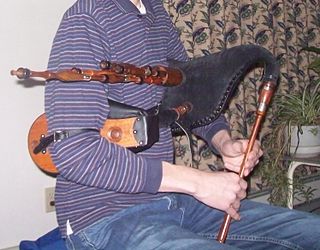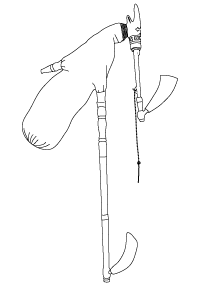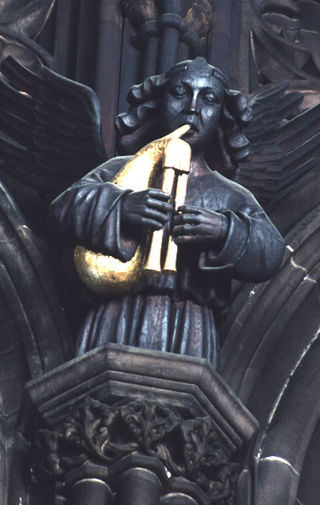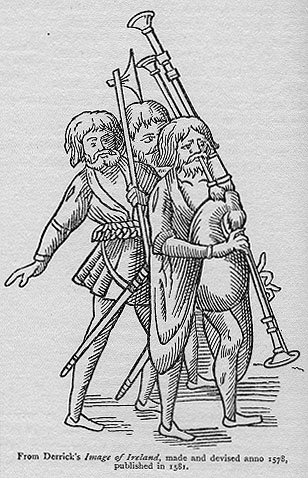
Bagpipes are a woodwind instrument using enclosed reeds fed from a constant reservoir of air in the form of a bag. The Great Highland bagpipes are well known, but people have played bagpipes for centuries throughout large parts of Europe, Northern Africa, Western Asia, around the Persian Gulf and northern parts of South Asia.

The uilleann pipes, also known as Union pipes and sometimes called Irish pipes, are the characteristic national bagpipe of Ireland. Their current name is a partial translation of the Irish language terms píobaí uilleann, from their method of inflation. There is no historical record of the name or use of the term uilleann pipes before the 20th century. It was an invention of Grattan Flood and the name stuck. People mistook the term 'union' to refer to the 1800 Act of Union; however, this is incorrect as Breandán Breathnach points out that a poem published in 1796 uses the term 'union'.

The great Highland bagpipe is a type of bagpipe native to Scotland, and the Scottish analogue to the great Irish warpipes. It has acquired widespread recognition through its usage in the British military and in pipe bands throughout the world.

The Scottish smallpipe is a bellows-blown bagpipe re-developed by Colin Ross and many others, adapted from an earlier design of the instrument. There are surviving bellows-blown examples of similar historical instruments as well as the mouth-blown Montgomery smallpipes, dated 1757, which are held in the National Museum of Scotland. Some instruments are being built as direct copies of historical examples, but few modern instruments are directly modelled on older examples; the modern instrument is typically larger and lower-pitched. The innovations leading to the modern instrument, in particular the design of the reeds, were largely taken from the Northumbrian smallpipes.

The Northumbrian smallpipes are bellows-blown bagpipes from Northeastern England, where they have been an important factor in the local musical culture for more than 250 years. The family of the Duke of Northumberland have had an official piper for over 250 years. The Northumbrian Pipers' Society was founded in 1928, to encourage the playing of the instrument and its music; Although there were so few players at times during the last century that some feared the tradition would die out, there are many players and makers of the instrument nowadays, and the Society has played a large role in this revival. In more recent times the Mayor of Gateshead and the Lord Mayor of Newcastle have both established a tradition of appointing official Northumbrian pipers.
Cornwall is a Celtic nation with a long musical history. Strengthened by a series of 20th century revivals, traditional folk music has a popular following. It is accompanied by traditions of pipers, brass and silver bands, male voice choirs, classical, electronic and popular music.

Saint Meriasek was a 6th-century Cornish and Breton saint. The legends of his life are known through Beunans Meriasek, a Cornish language play known from a single surviving manuscript copy dated 1504, and a few other sources. He is the patron saint of Camborne, and according to his legendary will his feast day is the first Friday in June.
Breage or Breaca is a saint venerated in Cornwall and South West England. According to her late hagiography, she was an Irish nun of the 5th or 6th century who founded a church in Cornwall. The village and civil parish of Breage in Cornwall are named after her, and the local Breage Parish Church is dedicated to her. She is a saint in the Eastern Orthodox Church and Catholic Church.

The culture of Cornwall forms part of the culture of the United Kingdom, but has distinct customs, traditions and peculiarities. Cornwall has many strong local traditions. After many years of decline, Cornish culture has undergone a strong revival, and many groups exist to promote Cornwall's culture and language today.

The Hungarian duda is the traditional bagpipe of Hungary. It is an example of a group of bagpipes called Medio-Carparthian bagpipes.

Altarnun is a village and civil parish in Cornwall, England, United Kingdom. It lies 7 miles (11 km) west of Launceston on the north-eastern edge of Bodmin Moor at grid reference SX 223 811.

Welsh bagpipes are a related instrument to one type of bagpipe, a chanter, which when played without the bag and drone is called a pibgorn. The generic term pibau which covers all woodwind instruments is also used in Welsh. They have been played, documented, represented and described in Wales since the fourteenth century. A piper in Welsh is called a pibydd or a pibgodwr.

Bewnans Ke is a Middle Cornish play on the life of Saint Kea or Ke, who was venerated in Cornwall, Brittany and elsewhere. It was written around 1500 but survives only in an incomplete manuscript from the second half of the 16th century. The play was entirely unknown until 2000, when it was identified among the private collection of J. E. Caerwyn Williams, which had been donated to the National Library of Wales after his death the previous year. The discovery proved one of the most significant finds in the study of Cornish literature and language.
This article defines a number of terms that are exclusive, or whose meaning is exclusive, to piping and pipers.
Cornish dance originates from Cornwall, UK. It has largely been shaped by the Cornish people and the industries they worked in. In most cases, particularly with the step dancing, the dances were still being performed across the region when they were collected.

The xeremia is a type of bagpipe native to the island of Majorca (Mallorca). It consists of a bag made of skin, known as a sac or sarró which retains the air, a blowpipe (bufador), a melody pipe or chanter (grall), and several, generally three, drones (bordons). The primary drone (roncó) sounds a tonic note, but the other drones are sometimes simply false drones for ornamentation.

Ricatus was a possible 11th-century king of Cornwall, although recent scholarship has cast doubt on his existence. If he existed, Ricatus may have been the penultimate Cornish king.

When bagpipes arrived in England is unknown, there is some evidence to suggest Anglo-Saxon times, however the oldest confirmed proof of the existence of bagpipes anywhere in the world comes from three separate sources in the 13th century. Two of them English; the Tenison Marginalie Psalter from Westminster and an entry into the accounts books of Edward the I of England recording the purchase of a set of bagpipes. The third from the Cantigas Del Santa Maria published in Spain. From the 14th century onwards, bagpipes start to appear in the historical records of European countries, however half the mentions come from England suggesting Bagpipes were more common in England.

Irish warpipes are an Irish analogue of the Scottish great Highland bagpipe. "Warpipes" is originally an English term. The first use of the Gaelic term in Ireland was recorded in a poem by Seán Ó Neachtain, in which the bagpipes are referred to as píb mhór.
















